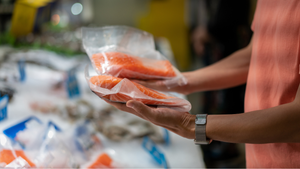Dollar General to Self-Distribute Fresh, Frozen FoodsDollar General to Self-Distribute Fresh, Frozen Foods
Move could reduce costs, widen assortment in fast-growing categories. The discounter said the move would reduce costs, widen assortment and provide a chance to execute better in fast-growing categories.

In a move officials believe will “control our destiny in fresh foods,” Dollar General has begun a move to self-distribute fresh and frozen foods.
The Goodlettsville, Tenn.-based retailer said the DG Fresh initiative has already launched through a cold-storage facility in Pottsville, Pa., which earlier this year began serving approximately 300 Dollar General stores in the Northeast. The discount retailer expects to be distributing its own fresh foods to as many as 5,000 stores by the end of its fiscal year next January, and chainwide in three to four years, CEO Todd Vasos said in a conference call.
Dollar General has used fresh, frozen and refrigerated foods to help build store traffic and comps as it has expanded to a nationwide discounter. These items, until now, have been supplied by a variety of regional distributors, and has tended to limit the company’s ability to differentiate in those departments.
Burt P. Flickinger III, managing partner with Strategic Resource Group, New York, said self-distribution could help Dollar General compete more directly with rivals in the supermarket business by expanding variety, lowering costs and giving it an opportunity to execute better in fresh food categories. He said the move could be the difference between upcharges of 25% to 35% vs. 3.5% to 5.5%.
Currently, the Pottsville facility is distributing the same items Dollar General previously procured from regional distributors, but Vasos said the DG Fresh initiative was designed so as to provide greater variety, including healthier items he said its customers want to see more of, while also helping to maintain better stock conditions at stores and allow for more items to come in under private brands. It will also help control the cost of goods, which Vasos said would lead to lower prices.
“It will allow us to control our own destiny in fresh foods,” he said. “Most notably, by distributing perishables ourselves, we can carry more of the fresh products and brands our customers want. These include better-for-you items and national brands.”
“Today there are many items we cannot cost effectively procure through our current model,” Vasos added. “In addition, self-distribution will allow us to offer a wider selection of our own private brands to provide our customers with even more compelling value.”
The move to self-distribution was one of two major initiatives announced Thursday while Dollar General reviewed financial results for the fourth quarter and 2018 fiscal year. Vasos also said the company would launch a program called “Fast Track” that will speed both the process of stocking shelves and for customers checking out with a self-checkout option.
The stocking program will focus on getting items from trucks to shelves more quickly and “will begin with fundamental changes at the distribution centers, which will make processes even more store-friendly, with products and deliveries sorted by location within the store,” Vasos said.
Dollar General said it would open 975 new stores in fiscal 2019 and renovate another 1,000—with half of the remodeled stores moving to the “Traditional Plus” format which includes expanded cooler space for fresh foods. About 200 stores will get fresh produce departments.
Dollar General had 425 stores with fresh produce as of December.
The company also has plans to open 10 small-format, urban friendly DGX stores this year. Dollar General has been testing the concept for two years. “We are now confident that we can drive profitability in this smaller box,” Vasos said.
In the fourth quarter, which ended Feb. 1, Dollar General said sales improved by 8.5% to $6.6 billion and comps jumped 4%, helped in part by an early dispersal of SNAP benefits related to the government shutdown. Gross margin percentage of 31.2% was down 91 basis points from last year’s fourth quarter. Officials said the lower profits related to promotional pricing and lower initial markups and by the SNAP pull-forward, which added which resulted in a lower margin mix.
About the Author
You May Also Like






